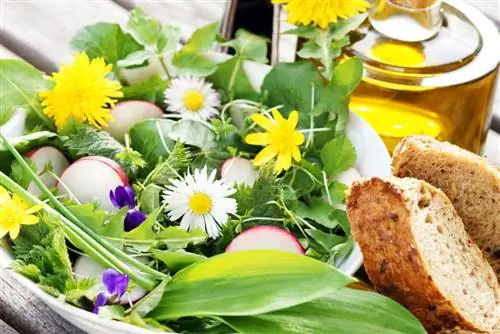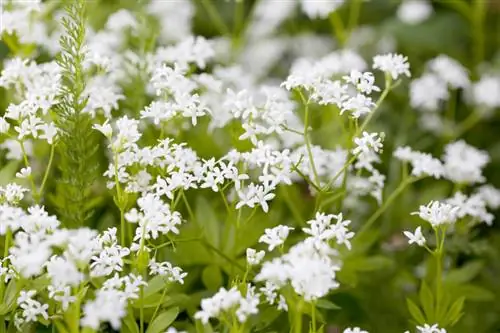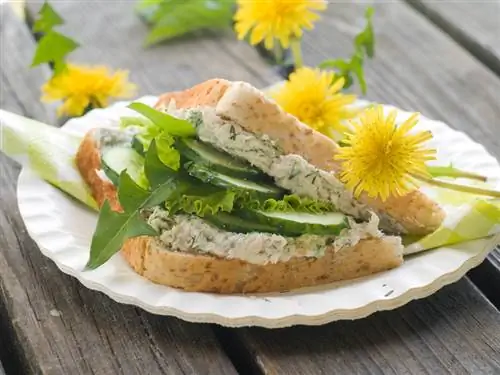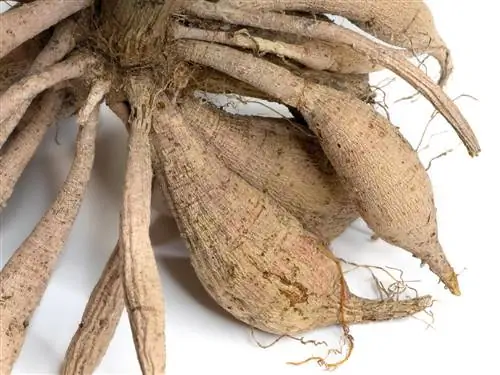- Author admin [email protected].
- Public 2023-12-16 16:46.
- Last modified 2025-06-01 06:02.
Many flowers grow in fields, forests and gardens that you can eat. This guide sheds light on the question of whether daisies belong to the illustrious circle of edible plants. All important questions about the consumption of Bellis perennis receive a comprehensible and practical answer here.
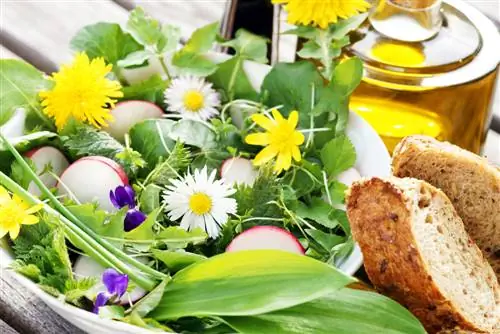
Can you eat daisies?
Daisies are edible and can be eaten raw in small quantities in salads, on bread or as tea. Their young leaves contain he althy vitamins and minerals. However, they should not be consumed in large quantities as they can be slightly toxic.
Can you eat daisies?
Daisies are edible and pack he althy vitamins. This is an interesting aspect of these distinctive wildflowers, which thrive ubiquitously in our regions and are useful as pastures for bees to swarm around. The following table summarizes which parts of a daisy are edible with tips for delicious eating options:
| Edible Bellis Parts | Enjoyment variant I | Enjoyment Variant II |
|---|---|---|
| leaves | freshly picked | as a salad |
| half-open flowers | raw | edible food decoration |
| Buds | raw | pickled |
| opened flowers | Salad addition | as tea |
| Seeds | roasted | raw as a salad addition |
| Roots | not edible |
Explanations for consumption
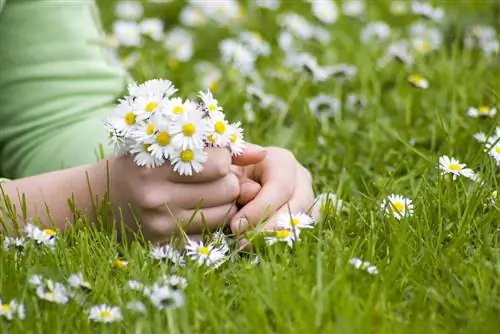
Young daisies taste best
The leaves gather to form a dense, ground-level rosette of leaves. Each leaf is composed of a petiole and leaf blade, which are almost the same length. You don't have to separate the two components because you can eat the leaves along with the stem. The younger a daisy leaf, the tastier and he althier. Bellis leaves taste particularly good when freshly picked and used as an ingredient in spring salads. In the modern kitchen, the vitamin-rich leaves spice up any green smoothie.
Typical basket flowers are characteristic of daisies. These are made up of up to 100 yellow tubular flowers, framed by white ray florets, arranged in two rows. Each flower is perched on a leafless stem 5 to 20 centimeters long. You can eat the flowers raw at any stage of growth, either without or with a stem. As tightly closed buds, they are also often pickled sour as a delicious caper substitute. From March to June, half-open flowers delight with a slightly nutty aroma. Fully opened daisy flowers taste slightly spicy to bitter, which is recommended for consumption as a salad addition or tea.
Withered flowers turn into fruit with tiny seeds. You can eat the seeds raw or roast them in the pan as a nutty salad addition. If you are not afraid of the high collection effort, daisy seeds provide a rich source of vitamins for autumn and winter.
Tip
Keep your eyes open when collecting daisies for consumption. Preferably pick the flowers in your own garden. Avoid locations on busy roads, in industrial areas and in the immediate vicinity of chemically sprayed fields. Daisies absorb pollutants through their roots, which you and your family eat along with the leaves, buds and flowers.

Eating daisies - 2 recipes
With the right recipe you can beat the sharp, bitter taste of daisies. One of the most popular preparation variations turns daisy buds into a tasty caper substitute. The following recipes may inspire your culinary imagination to enjoy star-quality daisies:
Candied daisies
The foolproof recipe requires three ingredients: 1 handful of daisies with stems, 100 ml water and 125 g sugar. Follow these steps to prepare it:
- Boil water in a pot
- Stir in sugar until all crystals dissolve
- Remove the pot from the fire and let the syrup cool down
- Meanwhile, clean the daisies under running water
- Embrace the flower stem at the bottom
- Drawing daisies through the liquid
Let the candied daisies dry on baking paper. It's quicker in the oven at 50 degrees. Sugared daisies add a decorative touch to any spring cake. For children with a sweet tooth, candied daisies are ideal as an edible decoration on the cup cake.
Pickled buds as a caper substitute
The following daisy recipe is aimed at fans of spicy delicacies. Tightly closed flower buds act as a hearty caper substitute with a variety of uses. The ingredients required are: 2 cups of tightly closed buds (without stems), half a teaspoon of sea s alt (or normal kitchen s alt) and 125 milliliters of tarragon vinegar or herb vinegar to taste. This is how you prepare it:
- Wash the buds and pat dry with a kitchen towel
- place in a bowl and sprinkle with s alt
- Let stand for 3 hours
- Boil the vinegar in the pot
- Add s alted buds and let them bubble up briefly
- Lift the buds out of the vinegar using a sieve and fill them into a screw-top jar
- Boil the vinegar again and pour over the fake capers
Let the capers rest in a closed screw-top jar for 3 to 4 days in a dark, cool place. Then strain the daisy buds again, boil the vinegar and pour everything into the cleaned, tightly closed screw-top jar. After 14 days, the false capers are ready for spicy, aromatic consumption, for example with cold starters or as an ingredient in warm spaghetti sauce.
What effect do daisies have?

Daisy tea relieves cough
Daisies are full of valuable ingredients that are beneficial to human he alth. At least this is what folk medicine has been assuming for many generations. Although there is a lack of scientifically based evidence, the following effects of custom sweets cannot be dismissed:
- as tea: healing for coughs, fever, headaches and for blood purification
- as an ointment: effective for age spots, freckles, tumors, hip pain and for wound healing
- as crushed root: soothing for sore muscles, rheumatism, sprains and broken bones
- as seeds boiled in wine: helpful for liver problems and stomach and intestinal problems
The saponin bayogenin as well as various essential oils, tannins and bitter substances are primarily responsible for the traditional healing powers. In view of its numerous he alth-promoting effects, the daisy was named medicinal plant of the year in 2017.
Excursus
Daisies as a lucky charm
In popular belief, daisies are considered floral lucky charms. It is said that if you carry dried daisies with you that were picked on St. John's Day between 12 and 1 p.m., luck will always be in your favor. Those who eat the first three daisies in spring are spared toothache, fever and cough.
Can pets eat daisies?
To pamper beloved pets with a varied menu, turn your attention to daisies. The distinctive little flowers can be found in every meadow and bloom non-stop from spring to autumn. However, caution is advised because not every pet can eat daisies. The following table summarizes which animal species are allowed to snack on daisies and which are not:
| Pet | edible? |
|---|---|
| Dog | yes |
| Cat | yes |
| Bearded Dragon | yes |
| Rabbits, hares | no |
| Guinea pig | no |
| Hamster | no |
| budgies | conditional (flowers only) |
Veterinarians and pet experts primarily express concern when rodents eat large amounts of daisies. Rabbits, hares, hamsters and guinea pigs react to the essential oils contained in them with flatulence, vomiting and cramps. Budgies may snack on the flowers if they are wilted or dried and served without the stem. Experienced experts have no objection to feeding bearded dragons daisies, as long as the quantities are small. Wildflowers can also be added to the green food list for dogs and cats.
Frequently asked questions
Are daisies poisonous?

Daisies should only be consumed in small quantities
Daisies contain a combination of the saponin bayogenin with essential oils, mucilage, bitter substances and tannins. Consumption in small quantities is completely harmless to humans and animals. In fact, he althy vitamins and minerals are mainly contained in the young leaves. The seeds also serve as a he althy source of vitamins in autumn and winter. Like all wildflowers and medicinal herbs, daisies are slightly poisonous in large quantities and cause unpleasant symptoms such as stomach pain, nausea, vomiting and diarrhea.
Can my baby eat daisies?
Don't pay attention once and the daisy has disappeared into baby's mouth. This is no cause for concern because in small quantities daisies are edible and safe for a baby. The information center against poisoning at the University Hospital of Bonn points out that the flowers are slightly poisonous in large quantities. Saponins, essential oils and other substances contained in it cause nausea, diarrhea and vomiting. If these symptoms occur after eating daisies, please consult your pediatrician immediately.
Do geese eat daisies?
For geese, fresh greens, grains, legumes and fruit are at the top of the menu. Poultry do not disdain aromatic daisies and their juicy leaves. In natural gardens, geese are often kept as living lawnmowers because they eat everything that grows in a green area, including daisies.
How many daisies can you eat?
Daisies are edible, but not a culinary delight. The bitter, tannin and mucilaginous substances contained in combination with essential oils and saponins do not arouse the desire to fill your stomach with daisies. In fact, the wildflowers are slightly poisonous in large quantities. Limit consumption to 4 flowers and 10 leaves. Children eat a maximum of half the recommended adult portion of daisies.
Tip
The best time to harvest daisies is in April and May. Young leaves and closed buds promise a he althy, nutty, aromatic treat for the palate. The further the flowering period progresses, the higher the content of bitter substances, tannins and mucilage increases, which leaves an unpleasant taste on the tongue.

